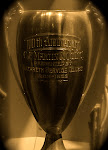
A notation from Grant Remaley's personal notebook.
An online magazine-preview of the upcoming book: BIRTH OF THE DREADNOUGHT The creation and development of C.F. Martin's Dreadnought guitar; and its consequences. Created by John Woodland Images and text; © 2013 John Woodland, unless otherwise noted. All Rights Reserved.


 Although C.F. Martin had produced a handful of artist-branded guitars prior to 1932, unlike other companies during the period, they didn’t market the instruments themselves. Guitarists such as Vahdah Olcott-Bickford who had been ordering numerous artist-branded guitars from Martin since the teens, were solely responsible for the marketing/sales of her exclusively branded line.
Although C.F. Martin had produced a handful of artist-branded guitars prior to 1932, unlike other companies during the period, they didn’t market the instruments themselves. Guitarists such as Vahdah Olcott-Bickford who had been ordering numerous artist-branded guitars from Martin since the teens, were solely responsible for the marketing/sales of her exclusively branded line. In 1934 Gibson produced the “Jumbo” line of Roy Smeck Stage Deluxe Hawaiian guitars. As the Wizard progressed throughout his career in the 1930s, he abandoned his favored Martin 00-40H for his newly endorsed model. However, according to Smeck, only a Martin was good enough.
In 1934 Gibson produced the “Jumbo” line of Roy Smeck Stage Deluxe Hawaiian guitars. As the Wizard progressed throughout his career in the 1930s, he abandoned his favored Martin 00-40H for his newly endorsed model. However, according to Smeck, only a Martin was good enough.


 (The initial 1934 T-fret sample from Horton Angell)
(The initial 1934 T-fret sample from Horton Angell)
 In Clinton F. Smith’s 1927 patent for a “Fret for Musical Instrument," the Attleboro, Massachusetts inventor notes his style ‘T’ wire “preferably disposed in an alternate arrangement, and are not oppositely positioned, although arranged on opposite sides of the fret wire… Each of these frets consists of a wire ‘4’ having lateral projections shaped like the barb of a fish hook as shown. This 'peculiar shape' permits of pushing the frets into place easily but project into the neck of the instrument to securely hold the fret in the place and reduces the possibility of their coming loose when the instrument is in use.”
In Clinton F. Smith’s 1927 patent for a “Fret for Musical Instrument," the Attleboro, Massachusetts inventor notes his style ‘T’ wire “preferably disposed in an alternate arrangement, and are not oppositely positioned, although arranged on opposite sides of the fret wire… Each of these frets consists of a wire ‘4’ having lateral projections shaped like the barb of a fish hook as shown. This 'peculiar shape' permits of pushing the frets into place easily but project into the neck of the instrument to securely hold the fret in the place and reduces the possibility of their coming loose when the instrument is in use.”  It’s unclear in Martin’s records just how long they used the 30% nickel T-wire, and it’s possible it was only produced for this single order. Martin also ordered 100 pounds of 18% nickel wire in this same order, and it’s uncertain in their records as to which guitars received the wire with higher nickel content. It was found however, in Frank Henry Martin’s sales notations during the period, that a young independent luthier from New York was buying bar fretwire from C.F. Martin as early as 1931, presumably because they were manufacturing the unique, resilient wire themselves. John D’Angelico soon became a formative archtop guitar-maker in New York City, along with the fretwire produced at C.F. Martin’s North Street factory.
It’s unclear in Martin’s records just how long they used the 30% nickel T-wire, and it’s possible it was only produced for this single order. Martin also ordered 100 pounds of 18% nickel wire in this same order, and it’s uncertain in their records as to which guitars received the wire with higher nickel content. It was found however, in Frank Henry Martin’s sales notations during the period, that a young independent luthier from New York was buying bar fretwire from C.F. Martin as early as 1931, presumably because they were manufacturing the unique, resilient wire themselves. John D’Angelico soon became a formative archtop guitar-maker in New York City, along with the fretwire produced at C.F. Martin’s North Street factory.













